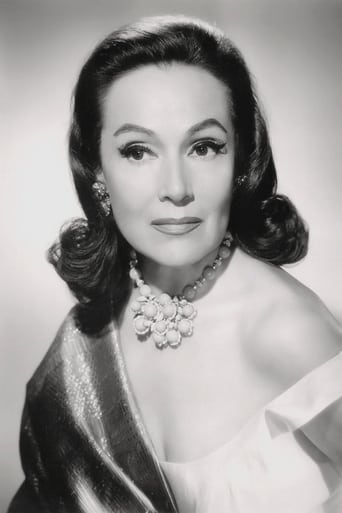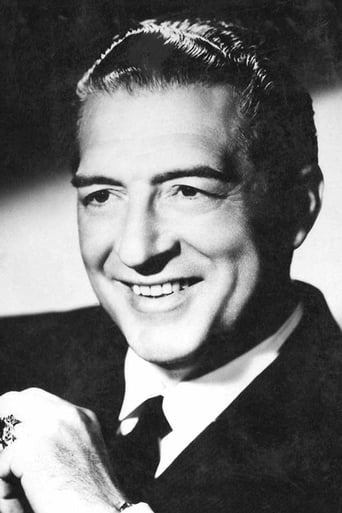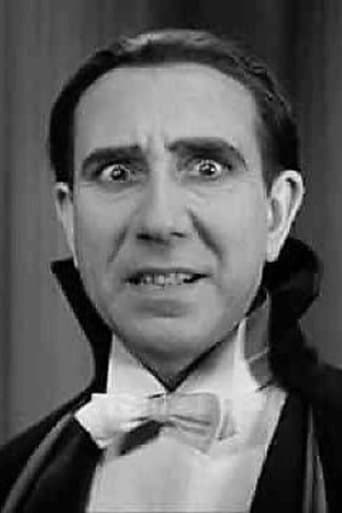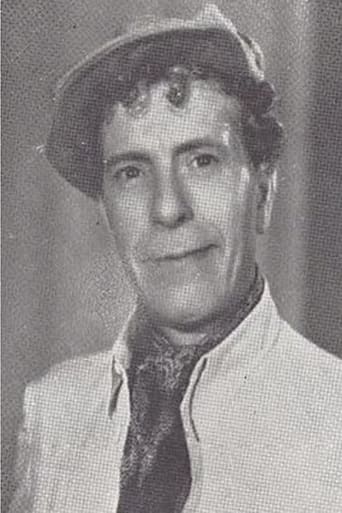AutCuddly
Great movie! If you want to be entertained and have a few good laughs, see this movie. The music is also very good,
HottWwjdIam
There is just so much movie here. For some it may be too much. But in the same secretly sarcastic way most telemarketers say the phrase, the title of this one is particularly apt.
StyleSk8r
At first rather annoying in its heavy emphasis on reenactments, this movie ultimately proves fascinating, simply because the complicated, highly dramatic tale it tells still almost defies belief.
Lela
The tone of this movie is interesting -- the stakes are both dramatic and high, but it's balanced with a lot of fun, tongue and cheek dialogue.
David Traversa
I just finished watching this movie on You Tube. As a warning, I think it fair to prevent the reader that my comment has been done leaving aside all logical thinking. I'm using only my gut feelings to say what I'm saying about this movie, otherwise it'll be impossible to accept the incredible script, awkward situations, cardboard like acting and impossible sets, all of it totally contrived, but maybe because of that it's such a watchable movie, because it's so bad that it's good, VERY good.Do I make any sense?? Since the other reviewers did an excellent job with their critics, I don't want to repeat impressions quite similar to my own. I just want to say that I'm still overwhelmed by the experience...What a movie, what a jewel of kitsch!!! I always adored, as a child, Dolores del Río (since then, I've come a long way...), although I never saw her at the peak of her supernatural beauty, when in the twenties and thirties of the 20th century she lived and worked in Hollywood and was considered one of the most beautiful and glamorous women of that time, in Hollywood or in any other place on earth (this movie --1946- makes her about 40 or older, but still ravishing). I agree with one of the reviewers about the scene where the detective and one of the twin sisters go to the bar where he used to go before "the incident" and he remembers his bride in front of this woman... I never whimpered so hard watching a scene as I did watching this one and long ago watching Philadelphia (1993). Finally, there are TWO LINES the detective says at the end of the movie that definitely will blow your mind sky high (the script is so good --in this particularly kitschy way-- that it'll be impossible to top it even nowadays).And the very last scene is unforgettable, since the doomed future of this tragic character weighs on the spectator with the force of a ten ton truck hitting you on the head. Seriously, I don't have words to express what this movie stirred in me, as bad as it is.Mexican movies of that time are incredible masterpieces (in that twisted way). The black and white photography, the impeccable Spanish pronunciation of these actors, the MOOD..., If I got that carried away watching this movie in my small computer screen, I cannot imagine what reaction I could've had at a movie theater, with the big screen and big sound. I suppose I would've been carried away between two alarmed nurses to the next hospital ward in utter anguished ecstasy.As I said at the beginning, relax, don't use the reasoning side of your brain and you'll have a hell of a fascinating time watching this movie.Just incredible.
JohnHowardReid
A masterpiece in any language, La Otra, in the skillful hands of its impeccable players and highly imaginative craftsmen, emerges as one of the most moving, dramatic and poignant experiences in the whole history of the cinema.I don't wish to give away too many details of a plot that is so brilliantly constructed that shock after shock after shock is tellingly delivered right up to the emotionally devastating finale. It's even too much to say that Dolores Del Rio has a dual role. The sudden revelation, when the widow finally lifts her veil, that the sisters are identical twins is the first of many startling twists in this tautly realistic yet wholly credible plot. Needless to say, Miss Del Rio not only plays both roles so brilliantly we always know which sister is on the screen (even when one wears the other's clothes), but manages the transformation with even greater finesse. Yet, at the same time, she always captures the viewer's complete sympathy.Victor Junco is wonderful in a showy role as the villain, but tends to obscure (on a first viewing anyway), the superb performance delivered by Agustin Irusta. The scene in which he re-enters the café with the "twin" is one of the most poignant and emotionally charged moments in world cinema. Director Gavaldon focuses our attention on his ravaged face as he explains his feelings to Magdalena, and it is impossible to remain unmoved at his despair.In this movie all the special effects are used to re-inforce the drama. They are not ends in themselves. In the confrontation scenes between the twins, I noticed only one effect on a first viewing. (There are actually two. The other is very subtle, yet far more dramatic). There are, however, many frightening visual effects when the house itself seems to take on an air of confrontational menace. What I didn't realize on a first viewing, is that it is actually in sound effects that the movie excels. If I were giving an award for the most imaginative and emotionally charged audio effects in the cinema, La Otra would top the list.To say Gavaldon's direction is absolutely brilliant would be to gravely underestimate his artistry and inventiveness. Mind you, he was able to take advantage not only of Alex Phillips' skillfully moody cinematography and Raul Lavista's emotive music score, but the amazingly atmospheric sets designed by Gunther Gerszo. True, these sets do become more terrifyingly expressionistic at the finale, but mostly they look—at first glance—elaborate yet pretty ordinary. But Gerszo has actually built hidden menaces into these sets, which Gavaldon and Phillips never fail to explore at just the right dramatic moments. It's difficult to credit that La Otra was edged out of a swag of Ariels by Enamorada—a movie I've not seen but am now eagerly looking forward to. It's hardly possible to imagine another 1946 Mexican nominee equaling or excelling the enervating emotional intensity of La Otra.
melvelvit-1
Manicurist Maria Mendez encounters her twin, Magdalena DeLago (Delores Del Rio in a dual role), at the funeral of Magdalena's wealthy husband. The two sisters have been estranged ever since Magdalena tricked Maria's sweetheart into marriage years before. At Magdalena's mansion Maria is in awe of her twin's opulent lifestyle and her long pent-up bitterness comes out. The fact that it all could have been hers makes her own life seem worthless even though her detective boyfriend Roberto (Augustin Irusta) loves her and wants to marry her. On Christmas Eve Maria lures her sister to her apartment and murders her. A suicide note makes it look like "Maria" shot herself and she assumes Magdalena's identity. Maria must think quickly, however, to surmount the obstacles that arise from her impersonation because Magdalena had a few dark secrets of her own. She has no choice but to play along with Magdalena's lounge-lizard lover, Fernando (Victor Junco), who helped Magdalena murder her husband. Fernando realizes she's an impostor and blackmails her but eventually confesses to authorities and there's poetic justice as the scheme to take over her sister's life comes crashing down. Maria finds out too late that you should beware of what you want...Filmed during "The Golden Age Of Mexican Cinema", LA OTRA is pure film noir in both look and world-view. Director Roberto Gavaldon crafted a moody tale of murder and suspense and gave it's lurid pulp aspects a glossy sheen while a sense of the macabre is conveyed through excellent use of chiaroscuro lighting. The opening credits unreel in outer space and the sets (which include a foreboding mansion, graveyard, morgue, courtroom, and a surreal prison) and thunderstorms give it the feel of a Gothic nightmare. The musical score is reminiscent of Universal horror films and the urban setting has a somber night-world ambiance with it's gleaming Packards, teeming rain, bus stops, restaurants and swank department stores.Beautiful Delores Del Rio had a successful career in Hollywood for almost twenty years before returning to her native Mexico in the early 40's to become one of it's most respected actresses and no expense was spared for this "A" picture. LA OTRA (The Other One) portrays Maria and Magdelena as reflections of each other and the twin sisters are multiplied by mirrors throughout the film. The differences are only on the surface, however. Maria is repressed and plain with up-swept hair and glasses while Magdalena is glamorous and cosmopolitan, swathed in furs and jewels. Both coveted what the other had in life and both never hesitated to resort to murder to achieve her selfish ends. Del Rio's textured portrayal of Maria makes the viewer feel her resentment and frustration. Wealth and luxury swirl around her as she struggles to get by, barely able to cope with depression, resentments, financial setbacks and sexual harassment on the job. She's fired from the barbershop for not being "nice" to the customers and she's unable to buy her boyfriend the Christmas gift she would have liked. It was desperate to do what she did in a moment's passion, throwing away her every-day existence and risking all for a chance to escape her unhappy lot. The Christmas Eve murder of Magdalena comes as an unexpected shock. Maria reaches into a drawer, pulls out a gun and puts a bullet in her sister's head as the scene cuts to the bursting of a piñata amid the sounds of fireworks. The audience is complicit in her crime and we hope she overcomes every curve thrown her way as the tension and twists mount once she assumes her sister's identity. Fear and doubt close in on Maria when she's alone in Magdalena's gloomy rococo mansion with a raging storm outside and a Great Dane who knows she's not it's mistress. The next day she finds out that Magdalena's husband never forgot what they did to her and provided for Maria in his will. At the police station to identify her "sister's" body, she meets up with Roberto and he reveals to "Magdalena" just how much he loved Maria. There's little time to ponder bitter ironies as her obsession to access her sister's millions meets more obstacles. She realizes during the reading of her late "husband's" will that she doesn't know her sister's handwriting so she burns her hand with a red-hot poker to get around this. Maria feels it was all worth it once she starts spending her ill-gotten gains on all the things she's only dreamed of, but the uncovering of her sister's secret love-life forces her into yet another corner. To keep her secret she sleeps with Magdalena's lover Fernando as he bleeds her dry through blackmail until his theft of a priceless El Greco painting from her library causes the whole charade to implode. The scheming ends in the cemetery where it began as the corpse of Magdalena's arsenic-riddled husband is exhumed. One final twist drives it all home for Maria: as Roberto walks her to prison for her "husband's" murder, she reveals to him that she is, in fact, Maria and not Magdalena. He turns away, preferring the image he has in his mind's eye of his "late" sweetheart.The final shot mirrors SUNSET BOULEVARD, but through a glass darkly. Maria, with shadows crossing her face, resembles Norma Desmond in her final "I'm ready for my close-up" shot. Madness reigns for both but with opposing reasons: Norma got what she wanted in a twisted way, while the twisted Maria got what she never expected.The original story by Rian James was later re-made in Hollywood as DEAD RINGER (1965) starring Bette Davis with an extra half-hour's worth of padding added to humanize a murderess. This dilutes the story's dark themes, thus making LA OTRA the more satisfying version.Highly recommended!
pldeaguinaga
Although I liked very much the detailed review of "Melvelvit" I would like to add that this interesting film, one of the best in the Mexican movies history, is due to the collaboration of American writer Rian James and one of the most important Mexican writers of the era, José Revueltas, and the Mexican film director Roberto Gavaldón. Actually, "La Otra" is one of the best Del Río and Gavaldón films, as well the set designer Gunther Gerszo (sometimes written Gerzso or Gerzo)and photographer Alex Phillips, all important figures in the artistic Mexican world. The "gothic nightmare... somber night-world ambiance" is due to Mexican Gerszo, who studied and worked at the Cleveland Play House in the USA, and combined his movie jobs with painting, becoming one of the most important Mexican abstract painters. In movies, he worked with John Ford ("Sombrerito", in Hollywood), John Houston ("Under the Volcano"), Luis Buñuel ("Susana", "Una mujer sin amor" and "El Bruto" with Kathy Jurado) as well with the most important Mexican directors. He did the sets for Mexican cult films "El Vampiro" (The Vampire) and its sequel, El Ataud del Vampiro" (The Vampire Coffin) about which he claimed, never even watched once they were finished (and they're great as camp Mexican movies examples!)





